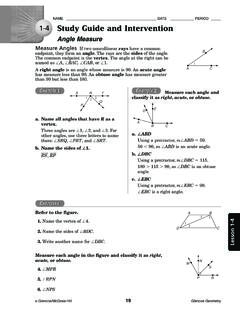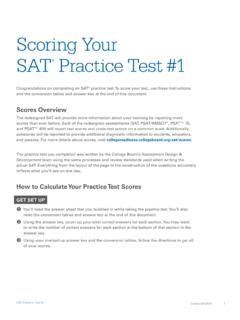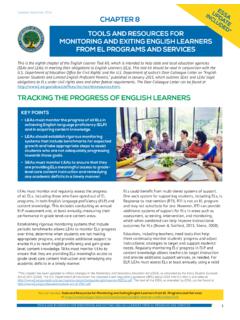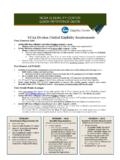Transcription of Formative Assessment Guide for Kindergarten English and ...
1 Formative Assessment Guide for Kindergarten English and Language Arts common core Standards 1 Listed below are suggested ways to formatively assess ELA common core Standards. Formative assessments are NOT limited to those listed below. However, Formative Assessment of all standards IS required. Text Usage (Standards a-c) Condition: Student is holding a text during small group instruction Observations: Orientation of text (upright) Visual tracking of text is top to bottom, left to right Follows print word by word Turns page by page Condition: Large or small group instruction Observation: Allow student to hold a pointing device and point to words as they are read aloud. Alphabet (Standards d, a-b) Condition: During small or large group instruction or independent practice Observation: Survey student recognition of upper and lowercase letters (Standard ) Condition: During independent practice Observation: Survey student ability to accurately print letters accurately Word Play (Standards a-e) Condition: During center games related to appropriate standards, large group and small group instruction Observation: Participation and accurate responses to games that involve rhyming, syllable play, and phonemic manipulation.
2 Teacher should note student s ability to manipulate phonemes, syllables, and words. Games may include: sorting rhyming cards sorting pictures by number of syllables I Spy a ___ (student must blend word after teacher segments it) Letter Tile manipulation of CVC words Formative Assessment Guide for Kindergarten English and Language Arts common core Standards 2 (Standard c) Condition: During small group reading instruction when student is instructed to read independently Observation: Note student s ability to read high frequency sight words fluently and in context Spelling (Standards , a,c,d) Condition: Traditional spelling tests to begin no later than third marking period Writing pieces Observation: Note if student s writing is demonstrating a letter-sound correlation Vocabulary (Standard ) Condition: Center time, small and large group instruction Observation.
3 Students dramatize words and their meanings with locomotive activities. (Standard ) Condition: Small and large group instruction, independent work Observation: Student can locate base words. Student can also describe how adding affixes changes the word meaning. (ex. Adding -s makes a word plural, adding ed changes the word to mean it already happened, etc.) (Standard ) Condition: Center games, small group instruction, large group instruction Observation: During sorting type games student is demonstrating ability to sort into categories (Standard ) Condition: Center games, small and large group instruction Observation: When student is able to name or dramatize opposites when prompted to do so. Formative Assessment Guide for Kindergarten English and Language Arts common core Standards 3 (Standard ) Condition: Large group instruction Observation: When given a description of an area, student is able to locate the area.
4 Could also have students develop collages that represent words and uses/meanings (Standard ) Condition: Large or small group instruction Observation: Allow students to act out the meaning of a word while other students locate the words in a posted word bank. (Standard ) Condition: Center times, free play, small and large group instruction Observation: During conversations, listen for students to use newly acquired vocabulary gathered from instruction, read alouds, etc. Sentence Writing (Standard , & d-f, b, ) Condition: Free discussion, independent work and guided practice Observation: Note student s ability to use nouns, verbs, plurals, prepositions, interrogatives, and complete sentences appropriately during conversations with adults and/or peers. Observation: During independent writing, note student s ability to write complete sentences including nouns and verbs.
5 If student attempts to use a plural, note if student includes appropriate suffix. If student attempts to use a preposition, note if student uses it appropriately. Writing Pieces (Standard ) Condition: Independent work Observation: When writing a sentence, student capitalizes the first word and includes appropriate ending punctuation. If the pronoun I is included anywhere within the sentence, it is capitalized. Formative Assessment Guide for Kindergarten English and Language Arts common core Standards 4 (Standard 8) Condition: Large group instruction Observation: Before writing a summative writing piece, write a piece with the same purpose as a class. Note student s ability to recognize their own opinions. Have student complete stems such as I like _____ , I think _____ is _____. Allow student to illustrate responses when appropriate.
6 Note student s ability to explain a process or provide information on a self selected topic. Allow student to use words and pictures to explain steps to complete a task. Allow student to illustrate information learned from a text. Note student s ability to tell a story (real or imagined) in sequential order. Allow student to use story maps to illustrate events from stories. Allow student to use words or drawings to tell about real experiences. Encourage and note when student observes and ask questions about displayed pictures and basic sentences. Allow student to enhance given sentences by adding words and details. Allow student to explore digital tools with a peer on ways to write, enhance, and publish stories for a class book. Allow student to demonstrate his/her comprehension of a topic learned about through read alouds with development of a flip book, poster, mobile, etc.
7 Allow student to use personal experiences or prior knowledge to respond to questions with responses recorded on class charts. Expressive and Receptive Communication (Standard a-b) Condition: Large group instruction, centers, recess, free play Observation: Note student ability to listen and take turns during conversation. In a more formal situation, use of a talking stick can reinforce student s ability to know when his/her turn is. Formative Assessment Guide for Kindergarten English and Language Arts common core Standards 5 (Standard ) Condition: Large or small group instruction Observation: Monitor during class discussion regarding read alouds, videos, etc. Does the student ask questions at points when the story may be unclear? (Standard ) Condition: Independent work time, group presentations Observation: Note if student uses a signal of some type (raised hand, signal card, etc.)
8 To receive assistance when clarification is needed. (Standard ) Condition: Small group discussion, free discussion Observation: Note if details are used in student conversations with adults and/or peers. (Standard ) Condition: Large and small group instruction Observation: After read alouds, allow students to use puppets or dramatization to add more detail (Standard ) Condition: Large and small group instruction, free conversation Observation: Monitor during daily conversations with student Reading (Standard , ) Condition: Large and small group instruction Observation: During informal conversations with partners, student will discuss important ideas in a previously read text. (Standard ) Condition: Large group instruction Observation: Have student tell a story using dramatization and props. Formative Assessment Guide for Kindergarten English and Language Arts common core Standards 6 (Standard ) Condition: Large and small group instruction Observation: Have student draw pictures to illustrate the topics of stories read aloud and explain them to partners (Standard ) Condition: Large and small group instruction Observation: After listening to read alouds, students identify the 5W s and the H (who, what, when, where, why, how).
9 (Standard ) Condition: Large and small group instruction Observation: After reading informational text, ask questions that require connections of characters, events, ideas, and/or information. (Standards , ) Condition: Large and small group instruction Observation: Before reading a text/story, have student predict unfamiliar words/vocabulary. After reading, revisit predictions and confirm or revise. (Standard ) Condition: Large and small group instruction Observation: Sort previously read texts by type. (Standard ) Condition: Large and small group instruction Observation: Have students use sticky notes to identify parts of a book. (Standards , ) Condition: Large and small group instruction Observation: Identify authors and illustrators of books read during group times. (Standards , ) Condition: Large and small group instruction Observation: Look at illustrations throughout a text and make predictions about the content of the text Formative Assessment Guide for Kindergarten English and Language Arts common core Standards 7 (Standard ) Condition: Large and small group instruction Observation: After reading a text, with support, student uses a graphic organizers to identify authors main points and supporting reasons.
10 (Standard , ) Condition: Large and small group instruction Observation: Use Venn diagrams to compare/contrast (Standard , ) Condition: Large and small group instruction Observation: Student participates in read alouds with repetitive story lines Student responds to texts by creating class books on topics.









